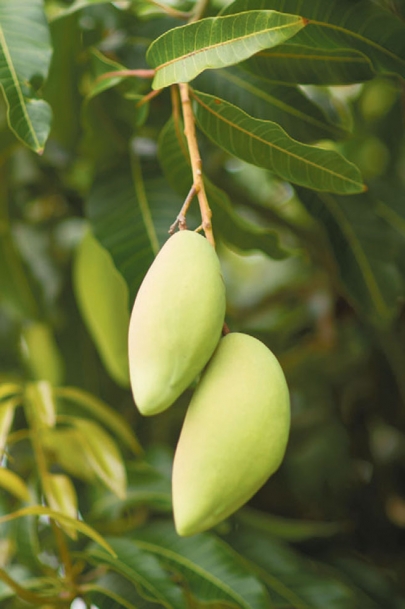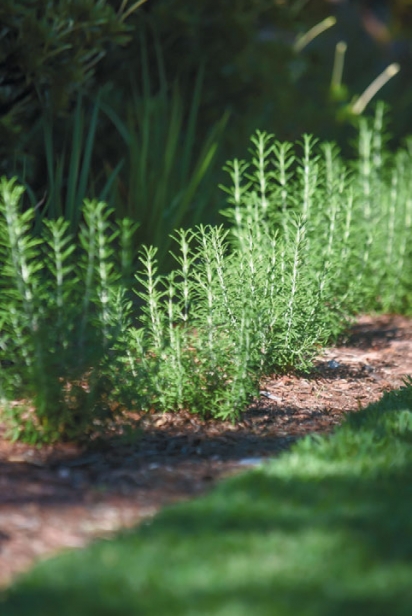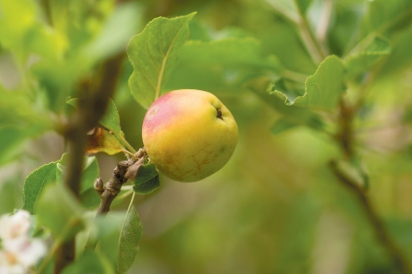Eat Your Yard
Edible Elements in the Residential Landscape
Fresher just tastes better. A squeeze of lime from a backyard tree or a snip of fresh tarragon can transform a recipe in a way that a big-box produce purchase simply can’t.
Many a home cook has placed a pot of herbs near a kitchen window, but few people consider edible elements when designing a new home, or planning a renovation. An edible approach to outdoor living can help reduce a home’s ecological footprint while making the landscape more productive, sustainable, and delicious.
There are several ways to incorporate edible elements into the residential landscape. Local landscape architect Michael A. Gilkey Jr. has created edible gardens for clients at a variety of scales, from raised cedar vegetable boxes to expansive mango orchards. He also uses edible species as part of his overall, everyday plant palette.
“I like the idea of using edible plants as design elements,” says Gilkey. “They can create space and emotion while giving the user not just a visual destination, but a physical one as well, with a tasty reward at the end.”
Gilkey is quick to point out that homeowners in Sarasota have many more choices than just citrus. Our climate supports the growing of other delicacies as well, including the macadamia nut tree, the lychee, and the tamarind, a staple in Indian cuisine. Some of Gilkey’s current favorite species include the recently released heat-tolerant cultivars of apple and peach trees, the Barbados cherry, and rosemary, in both shrub and trailing varieties. The Barbados cherry is a small tree that attracts birds and offers a small, antioxidant-rich fruit. Rosemary is durable and aromatic, which is a feature Gilkey enjoys employing.
“In our edible gardens we love the idea of incorporating aromatics, such as the allspice and bay rum trees,” says Gilkey. “Our clients tell us how lovely it is to walk through their gardens looking for ripe fruit, stopping along the way to crumple and smell a fragrant leaf. These additions can help transform edible elements into sensory experiences.”
From a design perspective, Gilkey also enjoys blending the edible with the nonedible to create rich combinations, like the tropical mix of bananas, heliconias, and gingers.
“Edible species can provide creative solutions to design needs,” says Gilkey. “Aloe, for example, is one of our favorite bedding plants.
It comes in many varieties and offers wonderful texture and a showy bloom cycle in late winter to spring. Another good example is the loquat tree, one of the few understory trees that thrives and produces in shady conditions.”
Taste and convenience aren’t the only benefits to an edible garden. Growing food at the residential level lowers our dependence on nonlocal agriculture, a key step toward a more responsible ecological footprint. It can also reduce the area of lawn on a property, turning consumptive space into productive space, and cutting down on water usage. And one of Gilkey’s favorite perks of edible gardening is the natural attraction of pollinating birds and insects.
“We can give a client an herb box or help them with vegetable crop rotation, but we are much more interested in the design of the perennial edible garden as it impacts the landscape,” says Gilkey. “We think about the health of the garden year-round. That includes pollination, flowering and fruit cycles, and sometimes dormancy. Utilizing edible species as landscape elements on an ongoing basis supports a healthy ecosystem, even on a residential scale.”
As with other plants, edible species that are not native or proven in Southwest Florida may require more chemicals to keep them productive. By selecting appropriate varieties, homeowners can maintain healthier plant and pollinator communities and reduce harmful runoff into our watershed.
Another opportunity for homeowners to reduce their ecological footprint comes at the end of the edible gardening cycle, through composting. Composting is the process of turning organic material, including food and yard waste, into naturally fertilizing soil through biodegradation. Since 20 percent or more of household garbage is compostable, the choice to compost can make a significant dent in a family’s impact on our landfills. However, some homeowners find it difficult to compost successfully on a small scale.
“For the inexperienced gardener, composting on a residential level can be challenging,” says Gilkey. “We support the opportunities for community composting that have become available in our area. They allow homeowners to recycle their food waste without having to manage the balance of materials themselves.”
Incorporating edible garden elements in the residential landscape allows families to produce and enjoy delicious local food while supporting a healthy ecosystem. It is the farm-to-table lifestyle in its purest, simplest form.











